Tonjiru (豚汁) is a hearty miso soup with pork slices and vegetables. Packed with loads of vegetables and a small amount of pork, tonjiru is quite filling but you will be surprised to know the calories in tonjiru are low. It is considered to be a winter dish in Japan but I can’t see why we shouldn’t have it all year round because it’s delicious.

The name came from pork/pig (豚) and soup (汁) because the key ingredient of this soup is pork. The kanji character “豚” can be read as “ton” or “buta” as Japanese reading of kanji usually has two (sometimes more) ways, i.e. the Chinese reading and Japanese reading. You might hear people calling this soup “butajiru” but the kanji characters are the same.
This is quite different from the usual miso soup as miso soups are normally just vegetables with no oil in them. Because of the fat content in this soup, people in Japan serve tonjiru in winter time, just like the Western style hearty soups are served in cold weather. When Sydney’s summer is over and the autumn weather starts kicking in, we sometimes get a chilly morning and night. On such days, I think of tonjiru.
Tonjiru does not get cold as fast as other miso soup because the surface of the soup is covered by a very thin film of oil from the pork. This film of oil keeps the soup hot, which is perfect on a cold day.
If you know how to make miso soup, you can make tonjiru easily. All you need to do is to sauté pork then vegetables, cook in dashi stock (preferred) or water and add miso. If you don’t know how to make miso soup, please visit my post, Miso Soup Basics.
The ingredients can vary household by household but the meat has to be pork, otherwise you can’t call it tonjiru.
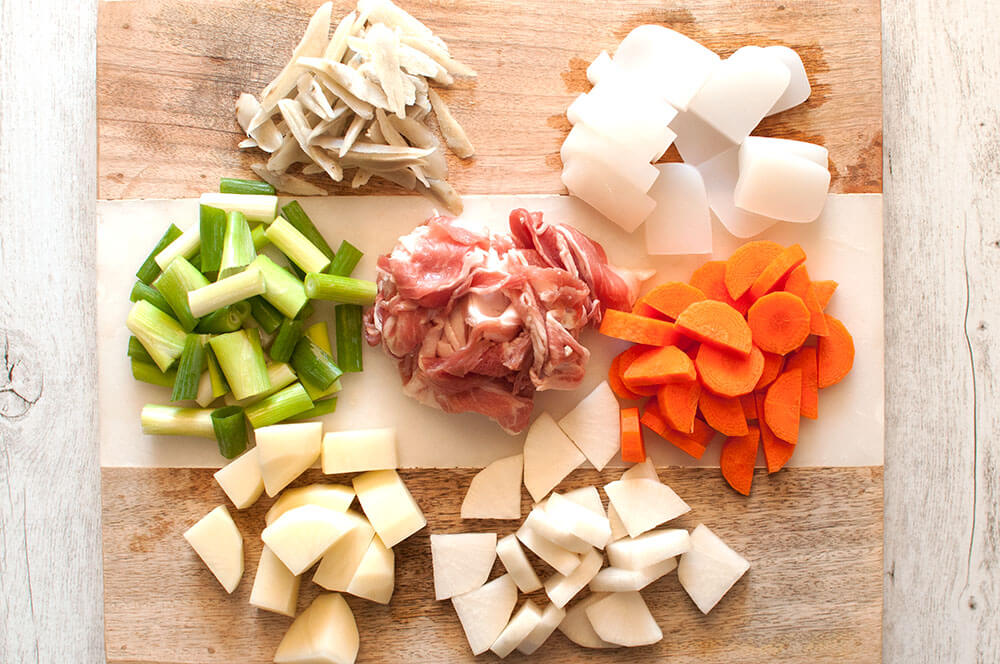
The cut of pork does not have to be pork belly but the meat has to be thinly sliced so that it gets cooked fast and tender. But I like pork belly as it makes the soup extra rich with additional fat. You could use slightly thicker slices of pork, if you like.
Typical vegetables added in tonjiru are daikon (white radish), carrot, taro, burdock, konnyaku, and shallots (scallions) but some people also add onion, tofu, aburaage (deep fried thin tofu), potato, string beans, and mushrooms, etc.
I touched on Konnyaku (こんにゃく) in my post, Sukiyaki when I was talking about shirataki. Konnyaku is made from konnyaku potato flour which has the texture of very firm jelly and sold as a block or small balls.
When konnyaku is cut into thin strips, it becomes ito konnyaku ( 糸こんにゃく) as it is called in the Kansai ( western) region of Japan or “shrataki” (しらたき) as it is called in the Kanto (eastern) region of Japan.
Konnyaku has virtually no calories and is high in fibre. It does not have much taste by itself but is used in a dish to give a different texture to the ingredients and/or volumes without increasing calories.
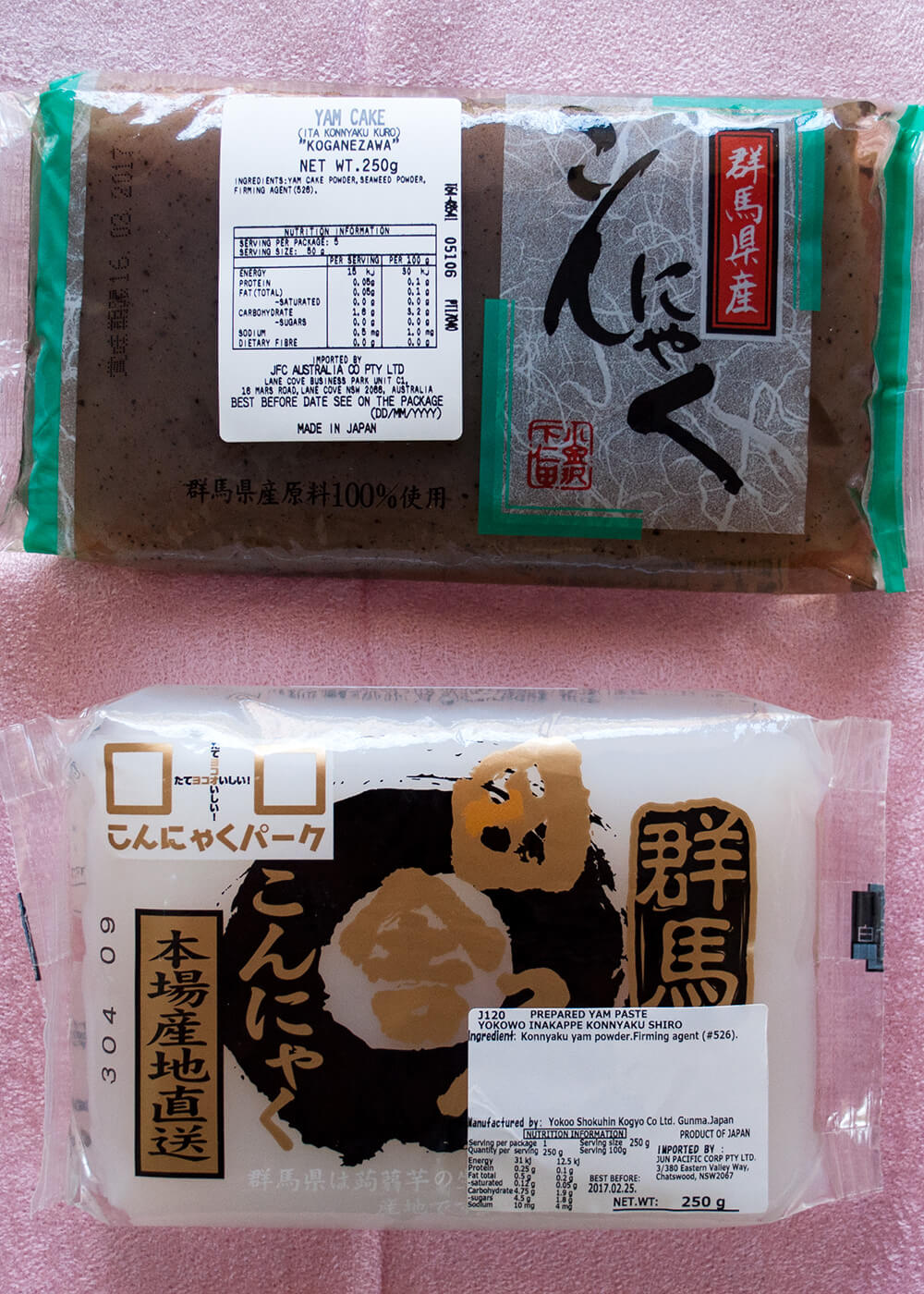
I used a pink garment on the table to show the colour of the konnyaku. It turned out to be too much pink and I know Nagi will have a fit.
The colour of konnyakun is usually light grey (bottom one in the above photo). But you may find very dark grey konnyaku with tiny black pieces in it. This is the konnyaku with seaweed (top one in the above photo). You might also see a greenish one or reddish one which are usually in a small ball shape. They have aonori (seaweed flakes) and tōgarashi (chilli) in it respectively.
You can buy konnyaku at Japanese/Asian grocery stores.
I wanted to use taro but I could not find it at the vegetable shop nearby so I used potato instead. I had a bag of frozen shredded burdock so I used it instead of getting a fresh burdock root and slicing it.
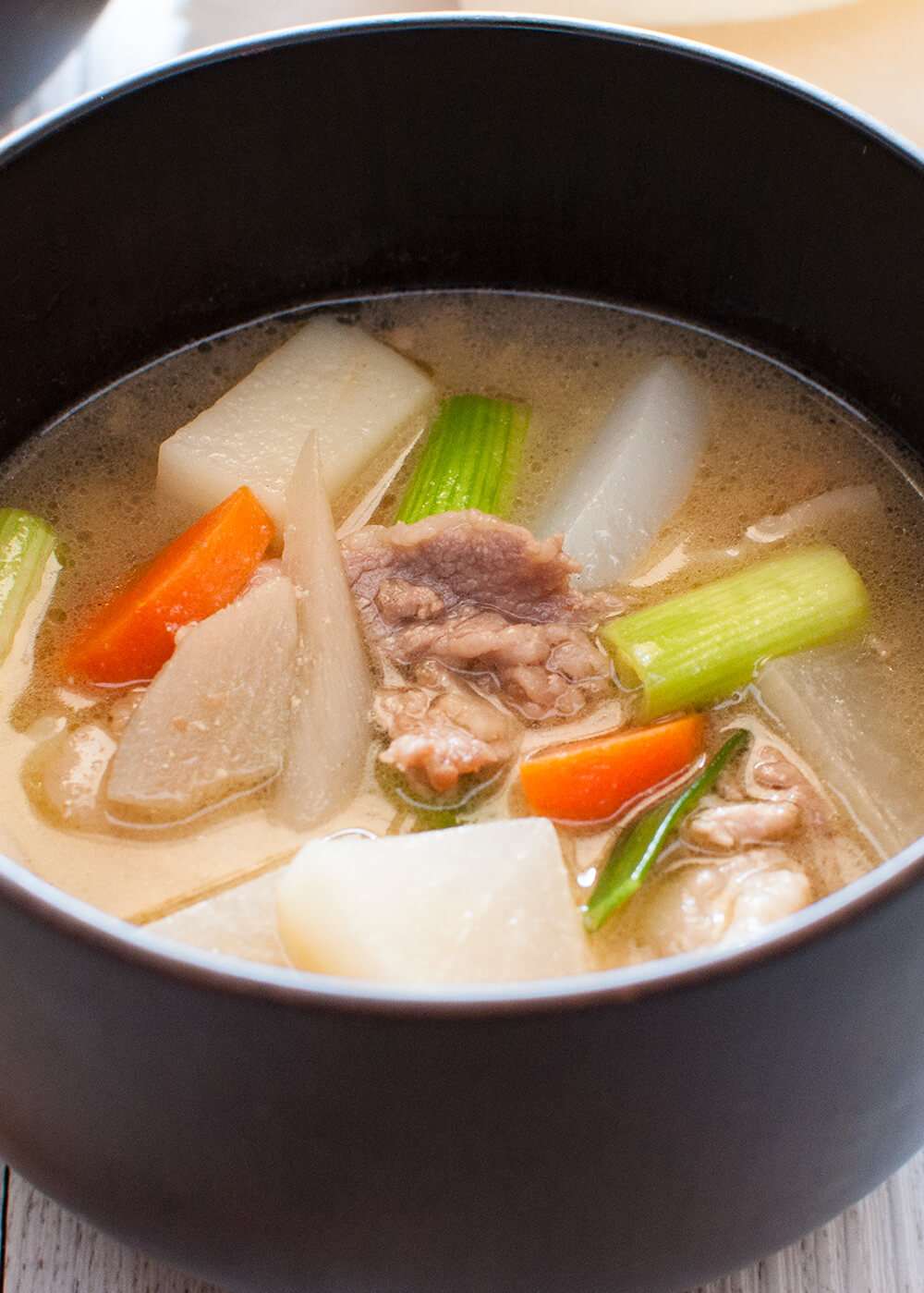
The way you cut the vegetables also varies. I sliced most of them but you can cut them into cubes or random shapes. As long as the size is similar and the cooking time is similar, no problems. The burdock I used would have cooked through faster than other vegetables since they were tiny and thin. But burdock is the kind of vegetable that will retain its shape even when cooked too long so it worked well. If I sliced the carrots too thin, for example, they would have cooked too soft and broken into pieces by the time the other vegetables were ready.
When you make miso soup and serve it in an owan (お椀, Japanese miso soup bowl), it is rather soupy and you don’t usually see much of ingredients in it on the surface. Tonjiru is quite the opposite. The ingredients are piled up in a bowl, usually showing above the surface of the miso soup. It is quite important to get the balance right between the amount of ingredients and the soup. If I can’t see the ingredients, then I would call it miso soup with pork and veges, not tonjiru. I hope you get the idea.
Tonjiru is sometimes topped with the white part of shallots (scallions) finely chopped, accompanied by a little bottle of shichimi tōgarashi (七味唐辛子), Japanese spice mixture with chilli) or simply called shichimi (七味). Here is a sample bowl of tonjiru with shallots and shichimi on top.
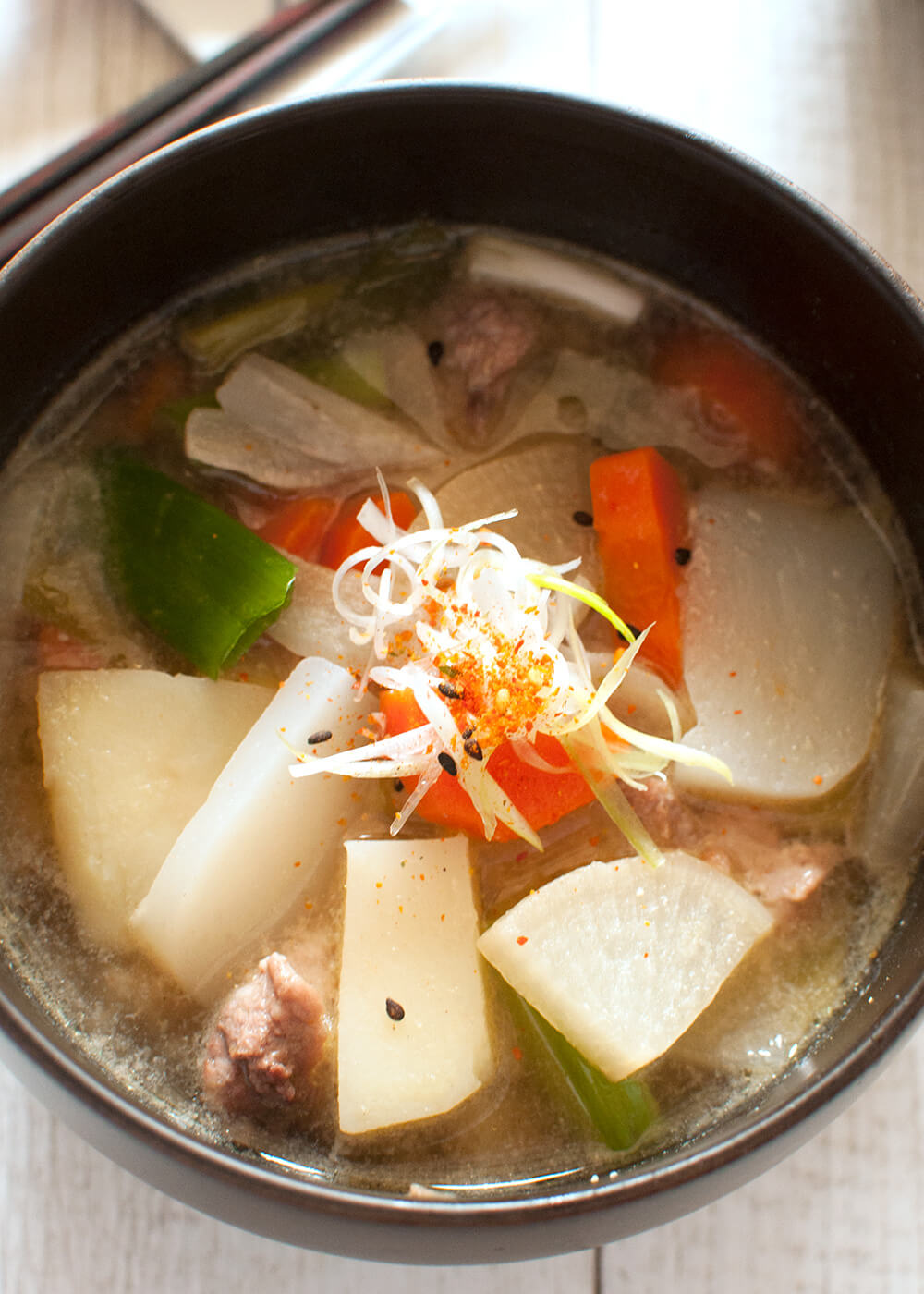
Shichimi means seven flavours while tōgarashi (唐辛子) means chilli pepper. It is also known as nanairo tōgarashi (七色唐辛子) meaning seven colour chilli pepper.
It contains seven or more different dry spices with chilli as the main ingredient. Other ingredients include sansho (Japanese pepper), orange peel, sesame, ginger, seaweed, hemp seed, and perilla.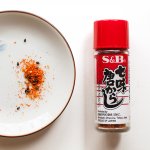
There are even specialty shops in Japan that usually have a long history in the business. Some shops let you choose ingredients to make your own version.
Shichimi tōgarashi goes well with miso based stew and Japanese style noodle soups, which I will post sometime this year.
When I feel that a main dish might be slightly light, I sometimes make tonjiru instead of normal miso soup to add extra volume to the meal. In this case, I serve tonjiru in a standard owan. But I sometimes eat tonjiru as a soup dish without a main, in which case I double the quantity and serve it in a large bowl just like the Western style soups.
Yumiko![]()
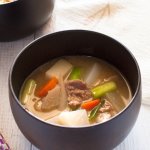
- 150g (5.3oz) pork belly , thinly sliced, cut into bite size pieces (note 1)
- 600ml (20.3oz) dashi stock (note 2)
- 2 tbsp miso (note 3)
- 100g (3.5oz) daikon (white radish), quartered and sliced 7mm thick
- 100g (3.5oz) carrots , halved and sliced 7mm (1/4") thick (note 5)
- ½ konnyaku block , halved lengthwise and sliced 7mm (1/4") thick (note 6)
- 100g (3.5oz) potatoes , cut into 2cm (3/4") cubes
- 40g (1.4oz) burdock , thinly sliced or shredded (note 7)
- 2 shallot (scallion) stems, chopped into 2.5cm (1”) lengths
- Julienned white part of shallots (scallions)
- Shichimi tōgarashi (Japanese spice mixture)
-
Heat a saucepan with a dash of oil (not in ingredients, note 8) and sauté pork over high heat until the surface of the pork is cooked.
-
Add all the vegetables except shallots to the pan and sauté until the surface of the vegetables are cooked (surface becomes semi-transparent in the case of potatoes).
-
Add dashi stock and bring to a boil. Reduce heat to low and cook for about 10 minutes or until vegetables are cooked through.
-
Add miso gradually, diluting into the soup. Add shallots, turn the heat up to medium low and cook for a couple of minutes.
-
Serve hot soup into a standard bowl or a large soup bowl topped with julienned shallots if using accompanied by tōgarashi.
1. You can use any cut of pork as long as it is not for stewing. It is important to slice the meat thinly into bite size pieces so that it cooks faster and is easier to eat.
2. Since the soup will be full of flavour from plenty of vegetables and meat, you can just use water instead. If you use dashi stock, it will add more umami to the soup.
3. Depending on the type of miso, and the brand within the same type of miso, saltiness varies. If you make dashi stock from the granular instant stock powder, it might contain salt as well. So, you will need to adjust the amount of miso by diluting the miso into the soup in stages.
4. The combinations of vegetables used in tonjiru can vary. You can add other vegetables according to what you have. Root vegetables good for stewing should be nice. I have listed some in my blog.
5. If the carrot is fat, you may need to quarter it lengthwise. The idea is to cut the root vegetables into the sizes so that their cooking time are similar.
6. Konnyaku is made from konnyaku potato flour which has the texture of very firm jelly and sold as a block or small balls. You can buy konnyaku at Japanese/Asian grocery stores. Please see my post above for details.
7. Burdock is not commonly sold in Sydney but some Asian vegetable shops or grocery stores sell fresh burdock which is a thin long root. However, you can find shredded or julienned frozen burdock at most Asian/Japanese grocery stores.
8. If the meat does not stick to the bottom of your pot when sautéed, there is no need to add oil since the pork belly contains streaks of fat in itself. I used oil because my pot was not good with it.
If you are using leaner meat, you may want to add a small amount of oil to sauté.
hi,
i make miso soup with a little bit of mirin. is that unusual?
Hi Piaba, it is not unusual, particularly when your miso is quite salty. A small amount of mirin makes the taste of the miso soup milder.
Hello, I am going to make this this week. Do you add the konnyaku at step 2? I’ve never used it before so unsure how long to cook it for. Thanks
Hi, Kelly. Yes, that is correct. Konnyaku does not disintegrate, even if you cook them for a very long time. I hope you like it.
Hi Yumiko,
Which miso do you use in your tonjiru recipe? I was overwhelmed with the amount of choices of miso nowadays (different colour, different ingredients, different brands) and I’d like to purchase the right one.
Thank you
Hi Carmelita, I can totally understand your problems in selecting a right miso.
1. Firstly, there are miso with dashi stock in it and without dashi stock. I would recommend buying miso without dashi stock. The dashi included in the miso does not give the best dashi flavour anyway. Also, you sometimes want to use miso without dashi stock.
2. Secondly, there are different colours of miso. If you visit my post, Miso Soup Basics, you will find detailed explanation of different types of miso.
3. In addition to the above, some miso come with bits of grains in it. The grains can be soy beans or rice grains which were left in the miso to give a different texture from the smooth miso. You can use either types of miso and it is totally up to you.
Miso for Tonjiru is usually brown miso or awase miso, which is also a most versatile miso. AS a rule of thumb, the expensive miso have better flavour.
Hi Yumiko
I chanced upon your blog and oh man, thank you for being such a blessing! Definitely bookmarking this for the near future where I will hopefully dominate the kitchen.
Blessings to you
Jeann
Hi Jeann, thank you very much for the kind words. Happy cooking!
Hello nami, recently I tried tonjiru and it did not come out with a flavor as intense as I expected, I hope to try this recipe but where I live I do not get burdock, what can I replace it with?
Also, I would like to be able to buy shichimi togarashi to be able to add it in this soup and I found this brand different from S & B by Amazon, have you ever seen it or tasted it in Japan? Is it good? Do you recommend any brand in particular?
https://www.amazon.com/Yawataya-Isogoro-Shichimi-Togarashi-14g/dp/B0049RFAQ4/ref=cm_cr_arp_d_product_top?ie=UTF8
Hi Ruth, parsnip can be a good alternate for burdock. You can also omit burdock and increase the quantity of other ingredients to make up for it.
The togarashi in the Amazon is probably better than S&B. I bought one in Japan and brought it back. It is slightly spicier but fragrance is great. The brand, Yawataya Isogoro is the long-established togarashi maker since 1736. If I have a choice of brands, I would buy Yawataya Isogoro brand.
This soup really looks very hearty and delicious. I will use your recipe.
I was searching on a pork tripe -daikon-miso soup dish that was featured in an episode of Anthony Bourdain’s “Parks Unknown” where he was brought to the house of sashimi master Masa where his mother prepared the pork dish.
I couldn’t make out some of the names of the ingredients nor the name of the dish, hence, my search.
Except for the use of pork tripe by the mother of Masa, your recipe looks very similar.
I am glad I came across your page. Will surely visit again. Thank you.
Hi Ricardo, I have not watched Bourdain’s episode you mentioned but I think the dish is ‘motsuni’ (モツ煮) which is a miso flavoured stew usually with pork stomach/intestines, konnyaku, daikon, carrot, shallots/scallions. Flavour of motsu-ni is a bit different from Tonjiru since you will get the smell and flavour of guts in the miso broth.
BTW, I love motsuni! If I can get fresh pork guts, I will definitely attempt to make it.
Hello from Brazil!
I’m in love with you website, congratulations and thank you for sharing your knowledge!!
: )
Dani
Thank you so much, Dani!
I
Thank you for good recipe! I cooked this soup in double size, plus I added some shiitake mushrooms and took small taro instead of potatoes (when washed a lot they taste better). I omitted spices, because my small son eats it too. For pork I took lean chop with fat removed and sliced very thin.
It came out very good and was still good next day, but I wonder, if I’m making big mistake when i cook it “slavic way” : by putting really A LOT of vegetables, till “spoon is standing”? Like I put whole gobo root, not 80 grams, and the same with the rest. How much would japanese person criticize this??
Hi Asa, there is no right and wrong in making miso soup. It is up to you.
However, if you call the dish miso soup, Japanese people would expect a certain amount of soup in the bowl so that you can see the surface of liquid. This is because Japanese cuisine has a particular dish type called ‘nitsuke’ or ‘nimono’ which is equivalent to simmered dish with lots of ingredients with small amount of flavoured soup. And if the liquid is not enough, they might think it is a miso flavoured nimono, not soup. But I don’t think Japanese people would criticise about your way of serving miso soup.
Thank you so much.
I hope you liked it.
Hi there,
This is Jenny from South Africa. I ant to ask you a question, please. I make your chicken chow mein quite often…I do the curing of the chicken with the baking soda…. it makes the best softest chicken eeeever!
What I do want to know…. is it possible to do the curing with beef and pork too?
I will appreciate your answer.
Thank you very much for super recipes.
Regards
Jenny Nel
Hi Jenny, sorry for the late reply. Your question is associated with Nagi’s recipe but came through to Tonjiru in RecipeTin Japan. So I passed your question to Nagi.
Nagi says: Yes it works with both beef and pork and Chinese restaurants do tenderise both of them too using same technique.
Thanks for loving Chew Mein!